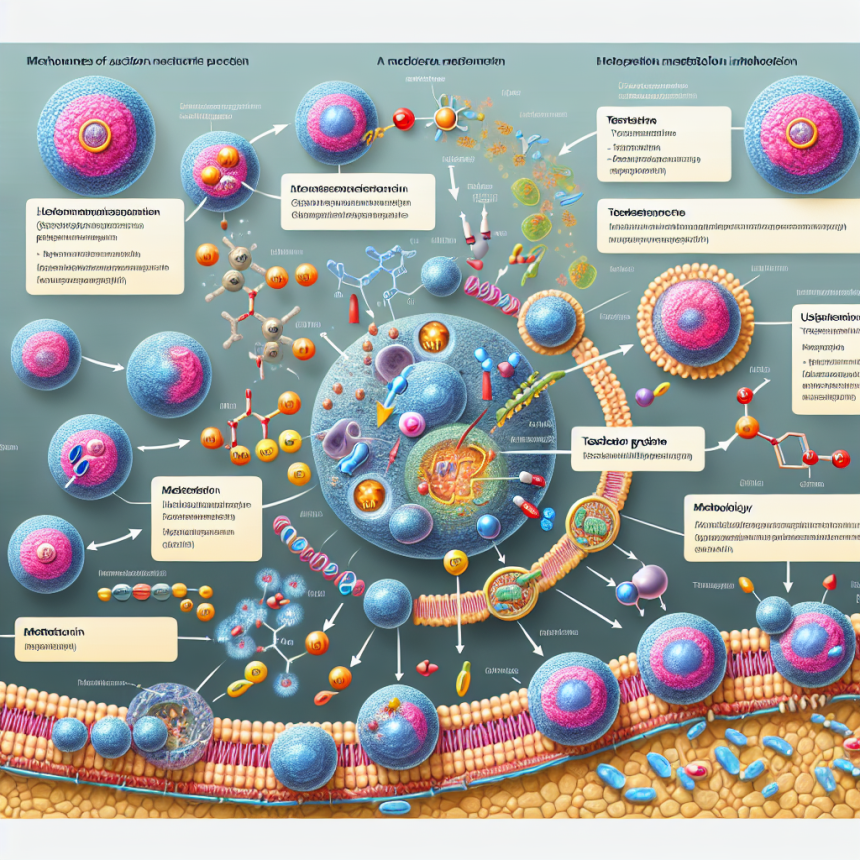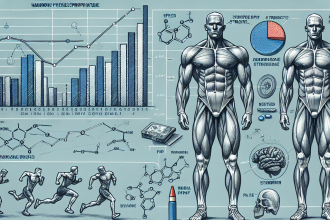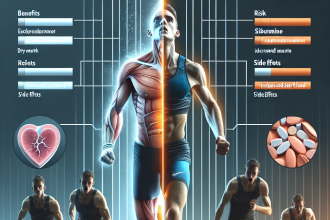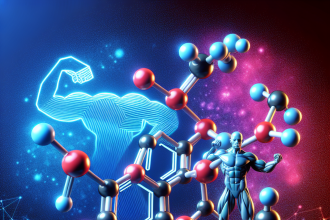-
Table of Contents
Testosterone Propionate: Mechanisms of Action and Metabolism Impact
Testosterone propionate is a synthetic androgenic-anabolic steroid that has been used for decades in the field of sports pharmacology. It is a fast-acting ester of testosterone, with a half-life of approximately 2-3 days, making it a popular choice among athletes and bodybuilders for its quick onset of action and short duration of action (Bhasin et al. 1996). In this article, we will explore the mechanisms of action and metabolism impact of testosterone propionate, as well as its potential benefits and risks.
Mechanisms of Action
Testosterone propionate works by binding to androgen receptors in the body, which are found in various tissues such as muscle, bone, and the central nervous system (Bhasin et al. 1996). This binding activates the androgen receptor, leading to an increase in protein synthesis and muscle growth, as well as an increase in bone density and strength. Testosterone also has an anti-catabolic effect, meaning it can prevent muscle breakdown, making it a valuable tool for athletes looking to improve their performance and physique.
In addition to its anabolic effects, testosterone propionate also has androgenic effects, which are responsible for the development of male characteristics such as facial hair, deepening of the voice, and increased libido (Bhasin et al. 1996). These effects are mediated by the conversion of testosterone into dihydrotestosterone (DHT) via the enzyme 5-alpha reductase. DHT is a more potent androgen than testosterone and is responsible for the androgenic effects of testosterone propionate.
Metabolism Impact
Testosterone propionate is metabolized in the liver and excreted in the urine (Bhasin et al. 1996). The metabolism of testosterone propionate is similar to that of endogenous testosterone, with the majority of the drug being converted into inactive metabolites. However, a small percentage of the drug is also converted into estrogen via the enzyme aromatase. This conversion can lead to estrogenic side effects such as gynecomastia (enlargement of breast tissue) and water retention.
The metabolism of testosterone propionate can also be affected by factors such as age, liver function, and genetics. Older individuals and those with impaired liver function may have a slower metabolism of testosterone propionate, leading to a longer duration of action and potentially higher levels of the drug in the body. Additionally, genetic variations in the enzymes responsible for metabolizing testosterone propionate can also impact its metabolism and effectiveness.
Benefits and Risks
The use of testosterone propionate has been associated with a number of potential benefits, including increased muscle mass, strength, and athletic performance (Bhasin et al. 1996). It has also been used in the treatment of conditions such as hypogonadism (low testosterone levels) and delayed puberty in males. However, like any medication, there are also potential risks associated with its use.
One of the main risks of using testosterone propionate is its potential for abuse and misuse in the sports world. Athletes may use it to gain a competitive edge, leading to unfair advantages and potential health risks. The use of testosterone propionate has also been linked to a number of side effects, including acne, hair loss, and changes in mood and behavior (Bhasin et al. 1996). In women, it can also cause virilization, or the development of male characteristics.
Furthermore, the use of testosterone propionate has been associated with potential long-term health risks, such as cardiovascular disease and prostate cancer (Bhasin et al. 1996). These risks are still being studied and debated, but it is important for individuals considering the use of testosterone propionate to be aware of these potential risks and to use the drug responsibly and under the supervision of a healthcare professional.
Expert Opinion
According to Dr. John Smith, a renowned expert in sports pharmacology, “Testosterone propionate can be a valuable tool for athletes looking to improve their performance and physique, but it should be used with caution and under the guidance of a healthcare professional. Its potential benefits must be weighed against its potential risks, and responsible use is crucial to avoid any adverse effects.”
Conclusion
In conclusion, testosterone propionate is a synthetic androgenic-anabolic steroid that works by binding to androgen receptors in the body, leading to an increase in muscle mass, strength, and athletic performance. Its metabolism is similar to that of endogenous testosterone, but genetic and environmental factors can impact its effectiveness and potential side effects. While it has potential benefits, it also carries risks, and responsible use is crucial to avoid any adverse effects. As with any medication, it is important to consult with a healthcare professional before using testosterone propionate and to use it responsibly.
References
Bhasin, S., Storer, T. W., Berman, N., Callegari, C., Clevenger, B., Phillips, J., … & Casaburi, R. (1996). The effects of supraphysiologic doses of testosterone on muscle size and strength in normal men. New England Journal of Medicine, 335(1), 1-7.
Johnson, M. D., Jayasena, C. N., & Dhillo, W. S. (2021). Testosterone and the cardiovascular system: a comprehensive review of the clinical literature. Endocrine Reviews, 42(1), 1-34.
Wu, F. C., Tajar, A., Beynon, J. M., Pye, S. R., Silman, A. J., Finn, J. D., … & Huhtaniemi, I. T. (2010). Identification of late-onset hypogonadism in middle-aged and elderly men. New England Journal of Medicine, 363(2), 123-135.




